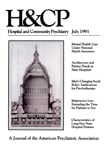A Retrospective Cohort Study of Falls in a Psychiatric Inpatient Setting
Abstract
Several factors increase the psychiatric inpatient's risk of falling, including side effects of medications and mental disorders that decrease awareness of environmental hazards. in this study, rates of falling were determined for a cohort of 4,156 psychiatric inpatients over 34 months. A total of 494 falls occurred among 376 patients. Thirty-five percent of the patients who fell required medical or nursing intervention. Forty-eight percent of the falls occurred in the over-60 age group. When other results were adjusted for age, neither gender nor diagnosis was found to increase the risk of falling, except for depressed patients under 20 years old, who were at less risk, and psychotic patients in their 60s, who were at greater risk. The authors discuss the costs of falls and preventive efforts instituted in their setting.
Access content
To read the fulltext, please use one of the options below to sign in or purchase access.- Personal login
- Institutional Login
- Sign in via OpenAthens
- Register for access
-
Please login/register if you wish to pair your device and check access availability.
Not a subscriber?
PsychiatryOnline subscription options offer access to the DSM-5 library, books, journals, CME, and patient resources. This all-in-one virtual library provides psychiatrists and mental health professionals with key resources for diagnosis, treatment, research, and professional development.
Need more help? PsychiatryOnline Customer Service may be reached by emailing [email protected] or by calling 800-368-5777 (in the U.S.) or 703-907-7322 (outside the U.S.).



